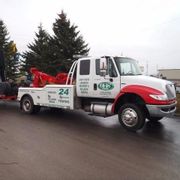Why It's Not Smart to Drive on a Low Gas Tank
By OHS Towing

When you think of car maintenance, you probably imagine tasks performed while your car is stationary—in a garage or on the driveway. However, one of the most important aspects of upkeep occurs while you’re on the road. Driving in a vehicle with a near-empty fuel tank can easily result in a stalled car and a panicked call to a towing service. To learn more about the dangers of low-fuel driving and how little is too little, consider the following guide.
Is It Dangerous to Drive With a Low-Fuel Reading?
 When your car’s fuel tank is past the ¼ mark, you’re in immediate danger of stalling. In most situations, coming to a sudden halt in the middle of the road is far from safe. On the highway, passing cars may be going up to 80 mph, and poor visibility or distracted driving will increase the chances of them clipping a stalled car. If you stall on a turn, other vehicles may not even see your car until they’re right behind it, resulting in a collision.
When your car’s fuel tank is past the ¼ mark, you’re in immediate danger of stalling. In most situations, coming to a sudden halt in the middle of the road is far from safe. On the highway, passing cars may be going up to 80 mph, and poor visibility or distracted driving will increase the chances of them clipping a stalled car. If you stall on a turn, other vehicles may not even see your car until they’re right behind it, resulting in a collision.
Worse, you may break down in the middle of nowhere, such as on a road trip, where it may be hard to find a towing service that can take care of you. If the weather is extremely hot or cold, and the car’s AC has no power, your health and that of your passengers could be in danger.
Are There Other Consequences?
In addition to the hazards it poses to people, driving on a near-empty tank could harm your car or truck. When the dial is headed for that dreaded “E,” your vehicle will strain itself to keep running, damaging the catalytic convertor. Plus, any build-up or debris sitting at the bottom of your fuel tank will be forced through the system, hurting the fuel pump.
While it’s smart to never drive with less than ¼ of a tank of gas, you may find yourself in need of towing services near Columbia Fall, MT. In this case, turn to OHS Towing for help. They’re proud to answer calls from drivers 24/7 in the Flathead Valley area. To learn more about their towing and roadside assistance services, visit their website or call (406) 892-1600 today.
About the Business
Have a question? Ask the experts!
Send your question

